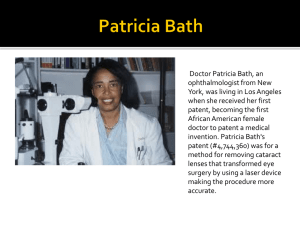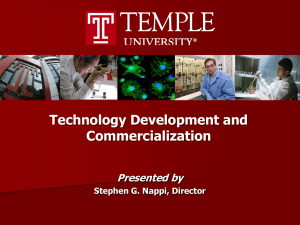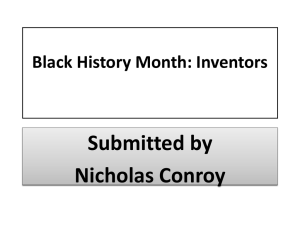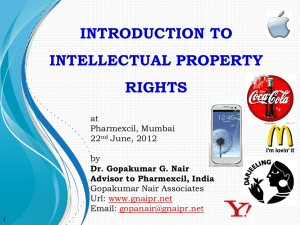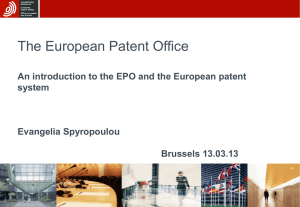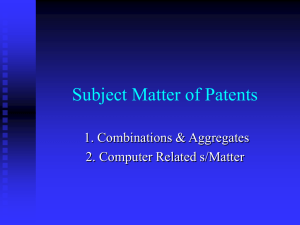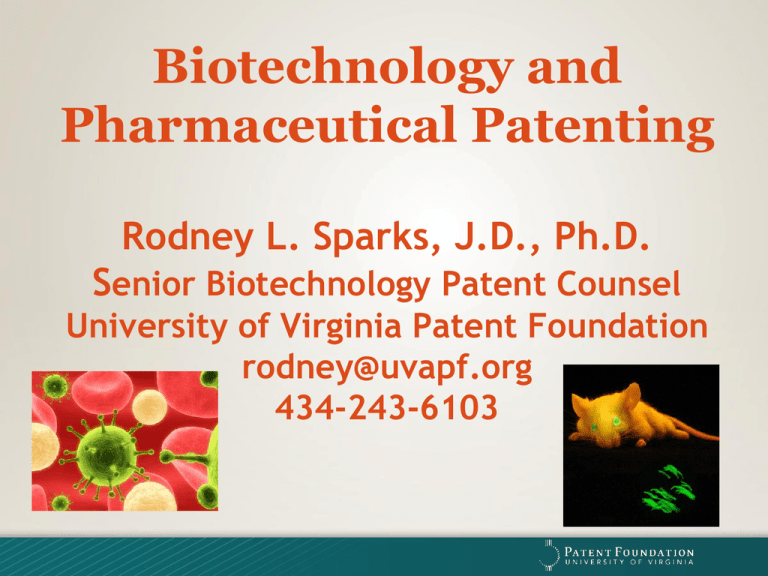
Biotechnology and
Pharmaceutical Patenting
Rodney L. Sparks, J.D., Ph.D.
Senior Biotechnology Patent Counsel
University of Virginia Patent Foundation
rodney@uvapf.org
434-243-6103
Disclaimer
• Please note that no legal advice is being
offered and no attorney-client
relationships will arise during this
presentation.
IP Rights are Provided for in the
Constitution
• Article I, Section 8: “The
Congress shall have power to
…promote the progress of
science and useful arts, by
securing for limited times to
authors and inventors the
exclusive right to their
respective writings and
discoveries”
Policy Behind IP Rights
• IP Law seeks to promote
creativity
• The property rights granted
protect the creators’
opportunities to recoup their
investment and earn a profit,
and encourages them to
invest their time and efforts
in developing new products
and services
Four Types of
Intellectual Property
•patents
• copyrights
•trademarks
•trade secrets
Four Types of
Intellectual Property con’t.
• Patents cover compounds, machines, and processes
• Give the right to exclude others from making, using,
offering for sale, selling, importing (they do not
necessarily allow you to practice your own patent!)
•Copyrights cover works of authorship reduced to a tangible
means of expression
• Give exclusive rights to copy, distribute, perform,
display, make derivative works
Four Types of
Intellectual Property con’t.
•Trademarks indicate source of goods and services
• prevent others from “passing off”
•Trade Secrets are legally protected secrets
• misappropriation is unlawful, but reverse engineering
is fair game
Patent requirements
An invention is not patentable unless it is
useful, novel, and non-obvious
• Utility (useful): proposed or demonstrated use
• Novelty: not previously described in a publication
• Non-obvious: not suggested by combinations of
publications
• Enablement: one of “ordinary skill” in that field
can carry it out (lack of data)
• Written Description: you can only claim as much
as you actually invented (lack of data)
• Best Mode: at the time of filing
What is Patentable?
What is Patentable?
“Anything under the sun made by man”
• New chemical compounds, e.g., drugs, pesticides
• Methods of producing new compounds
• Methods of diagnosing or treating diseases, including
biomarkers, delivery systems, and vaccines (no gene
therapy in humans)
• New uses for old compounds
• Purified natural materials, e.g., DNA, enzymes
• New formulations or mixtures, e.g., alloys, shampoo
• Transgenic animals or plants (excluding humans)
• Devices (stents, machines, orthopedic devices, prosthetics,
etc., and novel and non-obvious modifications thereof)
• Methods of performing a function by computer software
• Methods of doing business
• Methods of processing digital signals
WHAT IS NOT PATENTABLE?
• Patent law provides for what is patentable
and for what is not patentable.
• An invention is not patentable if it falls into
one of the following categories: perpetual
motion device; anti-gravity device;
abstract ideas or mental processes; laws
of nature or scientific principles; naturally
occurring substances; an invention
disclosed publicly more than 12 months
ago (includes sale, offer to sell, exhibit at
a trade show, publication); substituting
superior material for inferior material;
(cont).
WHAT IS NOT PATENTABLE? (con’t.)
• a mere change in size, form, or shape;
literary, dramatic, musical, and artistic
works (these are subject to copyright
laws); data structures or programs per
se; mere mathematical algorithms;
nonfunctional descriptive material;
electromagnetic signals; human beings;
an invention that is inoperative; an
invention which can only be used for
illegal or immoral purposes (such as a
torture device); and an invention solely
useful in making atomic weapons.
WHAT IS NOT PATENTABLE? (con’t.)
• Mere discoveries are not patentable
• A discovery can be thought of as
something which adds to human
knowledge, but does so by observation.
Discoveries include such things as
identification of a new species of plant, a
new biochemical pathway, naturally
occurring substances, or laws of nature.
• Once a discovery is made a modification
or new use of the discovery might be
patentable.
Correlation Between Patentability
and Commercial Value of an Invention
• NONE! (not quite true, but it makes my
point)
• A patentable invention may have little or
no commercial value
• An invention with a lot of commercial
value my have little chance of being
patented
• Dilemma- Without the potential for
adequate patent protection, most
companies will not invest in a technology
Evaluation of New Invention Disclosures
Invention
Disclosure
Copyright 2003
UVA Patent Foundation
All Rights Reserved
Triage
Patent
Protection
???
To File or Not to File?
General Triage Factors to Consider:
1. Preliminary Assessment of Patentability
(with an eye toward written description and
enablement issues due to too little data
and on novelty and obviousness issues
exposed in a prior art search)
2. Pre-market Analysis
3. Commercial Potential
From invention to patent
• Bad things- Public disclosure before filingresults in lack of novelty (kills foreign rights;
starts one year clock for filing in the U.S.); also
possible obviousness issues
• Presentations
• Publications (remember abstracts, web)
• Grant applications (once awarded- if federal)
• In use
• Good things- Inventors are diligent in filing
invention disclosures
• Lab notebooks (identify inventors and dates)
Good Invention Disclosurefor a cheaper and better result
• Invention has been fully completed and
many examples are in the invention
disclosure; make it easy for the licensing
associate and attorney to review it and to
be able to cut and paste necessary
portions of the disclosure in an efficient
manner
Good Invention Disclosurefor a cheaper and better result
• Well organized- such as draft manuscript;
a grant proposal, but only if there are a
lot of preliminary data; (keep total
documents to a minimum if possible)
• Editable (Word, etc.)
• Keep cited references to a minimum
Bad Invention Disclosureresults in a more expensive and less
desirable result
• Unorganized
• Incomplete - missing sections such as materials
and methods; incomplete description of results or
figures; figures with no accompanying legend or
which are not described in the text of the
disclosure
• Multiple unrelated documents (meeting abstract +
manuscript rough draft + grant proposal draft +
PowerPoint presentation = piecemeal disclosure)
• Uneditable files (pdf, etc.)
• A poster in PowerPoint
The patenting process
• Invention- disclose to UVAPF (180/year)
• Triage
• File Provisional application- 1 year (perform
inventorship determination if necessary;
remember- authorship is not the same as
inventorship)
• File International/PCT application- 1.5yr
• Nationalization: file in US, other countries
then you wait 2-3 years
• Prosecution, 1-2 years-
• Issued patent (maybe), 20 year term from
filing date (costs from $50k to $750k,
depending on the global scope)- Patents can
be challenged
Provisional Patent Applications
• The current PTO filing fee is $110
• With in-house patent counsel you can
draft and file many more provisional
patent applications than with outside law
firms where reasonable applications cost
from $2,500 to $12,000 in attorney’s
fees.
• We file 150/year!
Conversion of a Provisional Patent
Application to a PCT Application
• This decision requires more effort and is
tougher to make because the expenses
are much higher at this point (about $5k
just in government filing fees)
• If a licensee has been found in the year
since the provisional has been filed or if
there is a good chance for a license
agreement, a PCT application is usually
filed.
How do universities use patents?
• Universities patent and license the invention
(allowed by Bayh-Dole Act)
• A license is a contract in which the patent
owner allows a company to make, use, offer
for sale, sell, and/or import the patented
article or use the patented method
• In exchange, the “licensee” company pays
the patent owner royalties (usually a % of
sales) and other payments (e.g., up-front
fees, milestone fees)
• Royalties on successful products can be
huge! (even more than a graduate student’s
stipend)
Ownership of IP
at UVA
• Patents
• UVA owns inventions by contract
• Bayh-Dole Act (allows universities to
own federally funded research)
• Co-ownership with other entities
• MTAs, sponsored research agreements,
consulting can modify ownership
The UVA Patent
Foundation(technology transfer)
• Protection and licensing of UVA’s
inventions
• Bayh Dole government reporting
• Advice on intellectual property for UVA
(primarily for patents; some for
trademarks and copyrights)
UVA and the UVA Patent
Foundation Honor Inventors
2010 UVA Inventors of the Year
Tim Macdonald and Kevin Lynch
Some Familiar UVA Inventors
PATENT MYTHS
Myth #1: An inventor needs to know how
an invention works
•The inventor does not need to understand
how or why their invention works.
•If an inventor discovers a new method of
curing cancer, it does not matter how the
method works, just that it works.
O
PATENT MYTHS
H 2N
O
F
O
H 2N
O
Myth #2: An inventor needs a prototype
•If the invention is such a simple device that
drawings and a description will allow one of
ordinary skill in the art to make or practice
the invention, that is all that is needed. In
fact, if the invention is simple enough,
actual reduction to practice may not be
necessary (forget about this for
biotechnology).
PATENT MYTHS
Myth #3: An idea is patentable
•Although an idea is not patentable, if that idea
has been formulated in such detail that it can be
so clearly described in the specification that one
of ordinary skill in the art could make or practice
the invention based on the details provided in
the specification, then it might be possible to get
a patent on the idea.
•Few technologies other than simple machines
or simple processes fall into this category.
PATENT MYTHS
Myth #3: An idea is patentable (cont.)
For most technologies, such as
biotechnology, the standards of written
description and enablement are so high it is
difficult to get a patent even when there is
substantial data and actual reduction to
practice!
PATENT MYTHS
Myth #4: The preferred or best way of
practicing an invention can be kept secret by
exclusion from a patent application
Patent law requires that the “best mode” of
practicing the invention be included in the
application, if a best mode is known. Failure
to comply can result in invalidation of a
patent. If secrets are to be kept, then they
must be protected as a trade secret and are
not allowed in patent law.
Rodney L. Sparks, J.D., Ph.D.
Senior Biotechnology Patent Counsel
University of Virginia Patent Foundation
434-243-6103
rodney@uvapf.org

